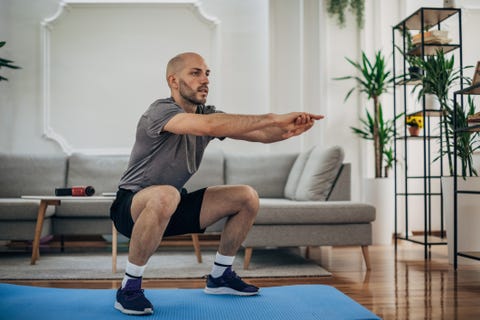There are some movements so foundational to your life that you might not think much of how you do them. Taking a walk, bending down to pick up something up off the ground, or stepping up onto a flight of stairs—all of these activities likely became rote to you a long time ago.
But once you put these types of movements in the service of a workout, the way you approach things tends to get a little more complicated. Think of bodyweight squats. The exercise is a staple for no-gear training routines, but the move’s simplicity hides a few important form cues you need to know to do it the right way. While you might not have any issues squatting down on your way to taking a seat in a low chair, your mechanics for the squat as an exercise might be all off as you attempt to mimic the latest video you saw of a trainer pumping through reps on Instagram.
Men’s Health fitness director Ebenezer Samuel, C.S.C.S. is here to help you fix that bodyweight squat form so your no-gear workouts can be all the better. Once you’ve got it down, you can level up safely when it comes time to progress the squat’s difficulty by adding other factors like tempo, load, and more.
How to Do the Bodyweight Squat the Right Way
Your main focus should be on how you lower yourself down, plain and simple. Get in the right mindset by following these steps from Samuel to learn how do bodyweight squats the right way.
Set Your Stance to Squat
Start by getting into a comfortable standing position, standing with your feet a bit wider than shoulder-width apart and your toes pointing out at a comfortable angle. This exact position won’t be the same for everyone, so don’t worry if you find yourself moving your stance slightly in or out. Just make sure you can stand and move comfortably without losing your balance.
Solidify Your Upper Body Before Squatting
As much as the bodyweight squat is a lower body-focused movement, you can’t forget about the waist up. Samuel says to “organize your upper body,” meaning your abs should be tight, shoulders rolled back, and your gaze straight ahead. One of the most important cues is to keep your chest upright. As Samuel notes, you’re not looking to bend over—so core engagement is paramount. “The thing that separates a squat from any sort of hinge motion is going to be that [the] chest is somewhat upright,” he says. Maintaining engagement in your core and shoulders is important for this.
Squat Butt First
One of the most common squatting mistakes is bending at the knees first. You’ll put yourself in a poor position if you do that, especially once you begin to progress the movement—so take Samuel’s advice and start bending at the butt. “Think about pushing back ever so slightly with [the] butt first,” Samuel says. “Start with that motion because it’s critical and that’s the only way you’re gonna squat right.” Once you’ve shifted back with your rear, bend your knees to continue your descent. As you bend your knees, squeeze your glutes to open them up, and shift your hands forward to counteract and imbalance that might throw you out of your stance.
How Low Should You Bodyweight Squat?
One of the most persistent debates in fitness has to do with squat depth. This argument is more commonly contended by barbell back squatters—but that doesn’t mean you’re out of line for asking how deep you should squat without any load. Samuel says the best depth is when your butt is just lower than your knees. Just because you hit depth doesn’t mean you should relax, though; keep your whole body engaged even “in the hole” (a.k.a. the bottom position of the squat). That goes double for your glutes. One of the biggest bodyweight squat mistakes is allowing your knees to cave in. Keeping your glutes engaged will help you avoid that error. Press through the ground with your feet and and extend your hips to stand to finish the movement.
How Should You Use Bodyweight Squats in a Workout?
While the bodyweight squat isn’t the most glamorous or complicated of exercises, it is one of the most versatile. Samuel advises using bodyweight squats as a warmup for leg day workouts that feature loaded variations of the exercise, or even as part of an interval session that will push yourself to complete reps in predetermined work and rest periods. If you’re looking for more involved workout, check out this 25-minute bodyweight challenge or this tough count-up series.
This content is created and maintained by a third party, and imported onto this page to help users provide their email addresses. You may be able to find more information about this and similar content at piano.io



Comments are closed.